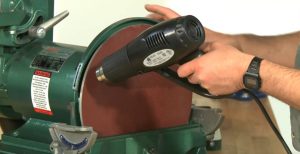A disc sander is an electrical tool that consists of sandpaper attached to a rotating disc and is used to grind and smooth the surfaces of the materials with which one works. It is often a very heavy sander, which will include a base and a table just in front of the rotating part. The disc sander is one of the most common types of sanders. This type of sander is usually fixed, unlike portable sander units.
 In addition to this type of sander, there is also what is called a belt sander. Both work almost on the same principle: pushing the abrasive paper at high speed, which will make sanding more efficient and complete. Choosing this option will probably increase the cost somewhat, but it may be worth it. The belt sander can be used for parts that the disk sander cannot undertake very easily.
In addition to this type of sander, there is also what is called a belt sander. Both work almost on the same principle: pushing the abrasive paper at high speed, which will make sanding more efficient and complete. Choosing this option will probably increase the cost somewhat, but it may be worth it. The belt sander can be used for parts that the disk sander cannot undertake very easily.
Other types of sanding machines can also be used, depending on the job. These include Random Orbital Sanders, Drum Sander and Straight-Line Sander. Often a sander will be used for one type or size of material and others for other parts. However, no matter how many individual pieces, they can be all used in the same project.
The material being sanded is placed on a table when working with a disc sander. Some adjustments and guides can help when working with edges that need to be precise. Once the sander turned on, the material is then moved to contact the sandpaper at will.
The disc sander can be used for many kinds of materials. Woodworking is perhaps the most common application. However, plastics and aluminium, as well as other softer metals, can also be shaped using this versatile tool. The owner’s manual accompanying the sander should indicate the materials that may be appropriate for use with the disc sander and those to be avoided.
One of the advantages of the disc sander is that it leaves both hands free to direct the wood or material at will. Typically, this type of sander is made of a more robust material, which allows the project to stay firmly on a flat surface and make it even easier for the user. However, make sure that the skin and clothing do not come in contact with the sander. It could lead to very serious and painful accidents. Younger adults using the machine should be closely monitored and informed of proper safety procedures before operating the machine.
The price of disc sanders depends on the model and the characteristics chosen. There are entry-level, factory-reconditioned models that can be found for less than $100 (USD), while commercial models run around $2,000 or more. Most home users will probably be satisfied with a machine in the price range of 150 USD to 350 USD. These models should be strong enough to last for years.


